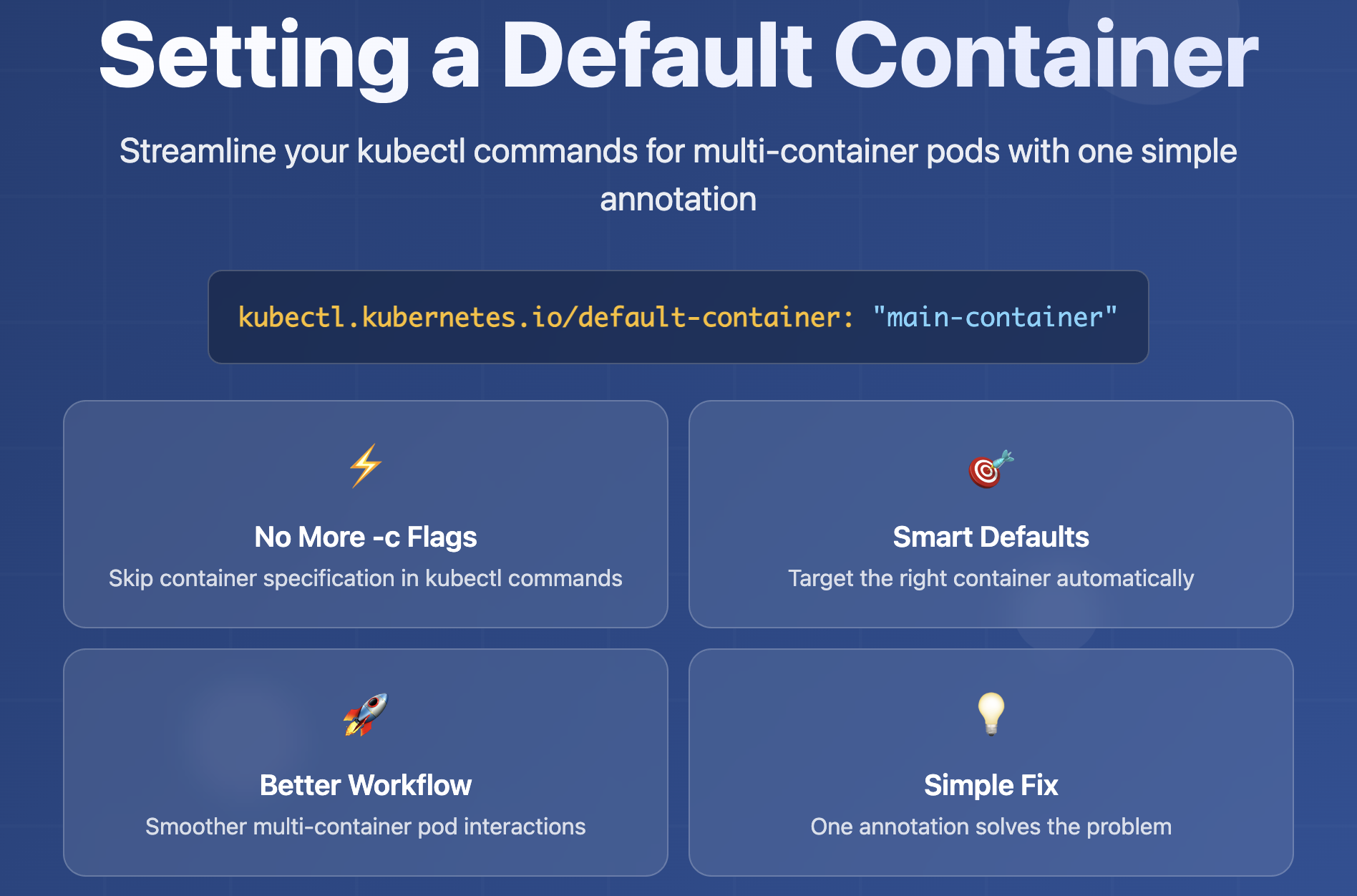Setting a Default Container in Kubernetes
A quick and easy fix to streamline your kubectl commands for multi-container pods.

When working with Kubernetes, you've likely encountered pods running multiple containers. This is a common and powerful pattern, often used for sidecars that handle tasks like logging, monitoring, or service mesh proxying. However, this setup can introduce a small but persistent annoyance: kubectl commands like logs and exec require you to specify which container you want to target.
If you forget the -c or --container flag, kubectl simply defaults to the first container defined in the pod's manifest. This might not be the container you're interested in, leading to repeated command corrections and a clunky workflow.
Fortunately, there's a simple and elegant solution to this problem: the kubectl.kubernetes.io/default-container annotation.
The Fix: A Simple Annotation
By adding this annotation to your pod's metadata, you can explicitly declare which container should be the default for kubectl commands. This eliminates the need to constantly specify the container name, making your interactions with multi-container pods much smoother.
The annotation is a key-value pair:
- Key:
kubectl.kubernetes.io/default-container - Value: The name of the container you want to set as the default.
You can apply this annotation in a few ways:
- During Pod Creation: Include the annotation directly in your pod's YAML manifest.
- To an Existing Pod: Use the
kubectl annotatecommand to add or update the annotation on a running pod.
Hands-On Example
Let's walk through a practical example to see how this works.
1. The Problem: A Pod with Two Containers
First, let's create a pod with two containers: a main application container and a sidecar container.
Create a file named multi-container-pod.yaml with the following content:
apiVersion: v1
kind: Pod
metadata:
name: my-app
spec:
containers:
- name: sidecar-container
image: busybox
command: ["/bin/sh", "-c", "while true; do echo 'I am a sidecar'; sleep 10; done"]
- name: main-container
image: nginx
ports:
- containerPort: 80
Now, create the pod using kubectl:
kubectl apply -f multi-container-pod.yaml
If you try to get the logs from this pod without specifying a container, kubectl will default to the first one listed in the manifest, which is sidecar-container:
kubectl logs my-app
You'll see the output from the sidecar:
I am a sidecar
To see the logs for the main-container (the NGINX container), you would need to explicitly specify it:
kubectl logs my-app -c main-container
2. The Solution: Applying the Annotation
Now, let's fix this by adding the kubectl.kubernetes.io/default-container annotation to our pod. We'll set main-container as the default.
Option A: Editing the Manifest
You can add the annotation directly to your multi-container-pod.yaml file:
apiVersion: v1
kind: Pod
metadata:
name: my-app
annotations:
kubectl.kubernetes.io/default-container: "main-container"
spec:
containers:
- name: sidecar-container
image: busybox
command: ["/bin/sh", "-c", "while true; do echo 'I am a sidecar'; sleep 10; done"]
- name: main-container
image: nginx
ports:
- containerPort: 80
Then, apply the changes:
kubectl apply -f multi-container-pod.yaml
Option B: Using kubectl annotate
If the pod is already running, you can add the annotation using the kubectl annotate command:
kubectl annotate pod my-app kubectl.kubernetes.io/default-container="main-container"
3. The Result: Simplified Commands
Now that the annotation is in place, try running the kubectl logs command again without specifying a container:
kubectl logs my-app
This time, you'll see the logs from the main-container by default, as you intended. Similarly, if you were to use kubectl exec, you would be dropped into the main-container.
By taking a moment to add this simple annotation, you can save yourself and your team a lot of time and frustration in the long run. It's a small change that can significantly improve your daily Kubernetes workflow.